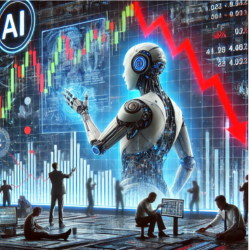Anúncios

The Limits of Artificial Intelligence in Financial Crises
In a world increasingly driven by algorithms, Artificial Intelligence (AI) plays a crucial role in predicting financial crises.
Major banks, investment funds, and governments rely on AI-based models to analyze market patterns, anticipate risks, and make strategic decisions.
However, no matter how advanced the technology is, there is one thing these models cannot replace: the human factor.
Financial crises are complex events, often triggered by unpredictable factors such as geopolitical changes, investor panic, and even systemic errors within the automated tools themselves.
In this article, we will explore the limitations of AI in predicting financial crises and discuss why, during periods of extreme instability, human intervention remains essential.
Anúncios
The Power and Promises of AI in the Financial Sector
Artificial Intelligence has transformed financial markets in various ways.
Advanced algorithms analyze vast amounts of data in real-time, identify investment opportunities, and automate processes that previously required human effort.
Some of the key benefits of AI in financial management include:
- Analysis of large data volumes: AI can process macroeconomic information, asset prices, financial reports, and even social media to predict trends.
- Automated trading: The use of algorithms in high-frequency trading (HFT) enables ultra-fast operations, capitalizing on minimal market fluctuations.
- Enhanced risk management: Predictive models help banks and investors make more informed decisions about credit and investments.
Despite these advantages, the limitations of Artificial Intelligence in financial crises become evident when these models face unforeseen events and systemic collapses.
The Main Applications of AI in Financial Crises and Its Challenges
Table 1 of the report “The Financial Stability Implications of Artificial Intelligence“, published by the Financial Stability Board (FSB), provides a comprehensive overview of AI’s key tasks in the financial sector, the learning methods used, and the most common use cases.
This analysis reinforces how AI can be a powerful tool but also highlights areas where the human factor remains essential to ensure market stability and security.
According to the report, the main tasks performed by AI include recognition, event detection, forecasting, personalization, interaction support, optimization, and knowledge-based reasoning.
To execute these functions, AI employs various learning techniques, such as supervised classification, reinforcement learning, and unsupervised learning, among others.

Some of the most relevant use cases include:
- Facial recognition for security and banking authentication.
- Fraud and risk detection, helping financial institutions identify suspicious transaction patterns.
- Stock price forecasting and risk modeling, optimizing investment decisions.
- Virtual assistants and chatbots, providing customer support and personalized services.
- Financial scenario simulation, allowing companies to test strategies in different economic contexts.
However, not all these applications are foolproof.
As discussed throughout this article, AI may struggle during crises, particularly when dealing with unprecedented events and qualitative factors that cannot be easily quantified.
The FSB itself warns that excessive reliance on AI can amplify financial instabilities, reinforcing the need for human oversight.
For this reason, Table 1 of the report underscores that while AI brings efficiency and innovation to the financial sector, its use must be accompanied by caution and constant monitoring.
After all, the human ability to interpret subjective information and respond to unexpected events has not yet been fully replaced by technology.
The Problem of Historical Data: AI Does Not Learn from the Unprecedented
One of AI’s biggest challenges is its reliance on historical data to predict the future.
The problem? Financial crises often do not follow previous patterns.
Since AI models base their forecasts on past data, they may fail to anticipate events that have never occurred before.
The Futurium article “Human Insight vs. AI in Extreme Financial Crises” highlights how AI struggles to handle long-tail events—rare and severe crises like the 2008 financial collapse or the sudden COVID-19 market crash in 2020.
These events deviate from the norm and, therefore, escape the predictive capabilities of algorithms.
You will be redirected to another website
Moreover, AI can create a false sense of security by providing forecasts based on historical patterns.
This can lead managers and investors to over-rely on automated models, overlooking warning signs that a human analyst might detect.
AI’s Role in Amplifying Financial Crises: The Risk of Automated Models
Rather than merely failing to predict crises, AI can also exacerbate them. The Centre for Economic Policy Research report “How AI Can Undermine Financial Stability“ highlights that AI can amplify market fluctuations by reacting homogeneously to certain conditions.
This happens because many models use the same datasets and decision-making strategies.
When a warning signal appears, high-frequency trading (HFT) algorithms may trigger mass sell-offs, causing a herd effect and accelerating the collapse.
This phenomenon was evident in the 2010 Flash Crash, when automated trading orders led to a sudden market plunge within minutes.
The European Central Bank, in its study “The Rise of Artificial Intelligence: Benefits and Risks for Financial Stability”, warns that AI could create a dangerous interdependence in the financial sector.
If multiple banks, investment funds, and brokerage firms rely on similar AI models, a systemic error could trigger a chain reaction with devastating consequences.
The Role of Artificial Intelligence in Financial Crises
Artificial intelligence has transformed the way we analyze and predict financial market events. Algorithms can process massive amounts of data in seconds, identifying patterns that human analysts might overlook. Some of AI’s key applications in this context include:
Predictive analysis: Machine learning models analyze market trends and anticipate potential crises.
Anomaly detection: Algorithms identify suspicious movements that may indicate imminent risks.
Decision automation: Algorithmic trading systems automatically adjust portfolios based on AI forecasts.
However, despite these advantages, AI is not infallible.
The predictability of financial crises depends on factors that cannot always be captured by historical data or statistical models.
The Limits of Artificial Intelligence in Predicting Financial Crises
While AI has revolutionized the financial sector, there are insurmountable barriers to its full effectiveness in crisis prediction. The main limitations include:
Lack of Data on Unprecedented Events
AI models are trained using historical data. However, financial crises often arise from unprecedented events.
The 2008 crisis, for instance, was driven by risky financial practices and a housing bubble—something that the models of the time failed to predict accurately.
As warned by the Futurium report, AI struggles to handle entirely new situations where no prior data exists for comparison.
Risk of the “Herd Effect”
When widely adopted by financial institutions, AI can create a collective reinforcement effect.
If many models rely on similar algorithms for decision-making, they may all react identically to a crisis event, amplifying market fluctuations instead of mitigating them.
A study by the European Central Bank highlights that this phenomenon can increase instability rather than reduce it.
Dependence on Reliable Data
AI relies on accurate data to make decisions. However, financial crises can be driven by misinformation, market manipulation, or incorrect data.
The Financial Stability Board warns that AI can be easily misled by fraud or sudden fluctuations, making it vulnerable to erroneous decisions.
Artificial Intelligence Cannot Understand Human Behavior
Financial crises are largely driven by psychological factors. Investor fear and euphoria can cause sudden market collapses—something AI is still unable to interpret effectively.
The Centre for Economic Policy Research emphasizes that AI cannot capture emotional nuances or irrational decisions, limiting its ability to predict crises with precision.
You will be redirected to another website.
Why Artificial Intelligence in Financial Crises Does Not Replace the Human Factor?
Given these limitations, the combination of AI and human judgment is essential to mitigating financial risks.
The article Beyond the Numbers: Why AI Can’t Replace Human Judgment in Accounting by Trullion emphasizes that while AI can optimize data analysis, it cannot replace human experience, creativity, and intuition.
Financial managers must be cautious not to fully delegate decision-making to algorithms. In times of crisis, the human factor enables:
Adaptive decision-making: Humans can consider unprecedented scenarios and adjust strategies flexibly.
Analysis of qualitative factors: Political, social, and psychological events influence markets in ways AI cannot fully interpret.
Conscious intervention: In financial collapses, human action can prevent automatic panic responses triggered by AI models.
Balancing Artificial Intelligence and Human Decision-Making
Since AI has limitations in financial crises, the ideal approach is a hybrid model:
AI as a support tool: Algorithms provide insights, but final decisions should involve human experts.
Continuous monitoring: Companies and governments must track AI usage to ensure it does not amplify market risks.
Diversification of models: Instead of relying on a single predictive model, financial institutions should use varied approaches to reduce vulnerabilities.
As emphasized by the International Monetary Fund (IMF), AI can be a powerful ally but should not replace human judgment in financial crisis management.
AI as a Tool, Not a Substitute
Artificial Intelligence has revolutionized the financial market, enabling faster and more detailed analyses.
However, its limitations in predicting financial crises show that technology alone is not enough to ensure economic stability.
Unpredictable factors, human behavior, and unprecedented events continue to challenge algorithmic models.
This is why balancing AI with human expertise is crucial to minimizing risks and preventing unexpected collapses.
In the end, while algorithms can help detect patterns, it is the human factor that brings intuition, ethics, and adaptability—qualities that no AI can replace. 🚀
References
Centre for Economic Policy Research. (n.d.). How AI can undermine financial stability.
European Central Bank. (n.d.). The rise of artificial intelligence: Benefits and risks for financial stability.
Financial Stability Board. (n.d.). The financial stability implications of artificial intelligence.
Futurium. (n.d.). Human insight vs. AI in extreme financial crises.
International Monetary Fund. (n.d.). Artificial intelligence and its impact on financial markets and financial stability.
International Monetary Fund. (n.d.). Opportunities and risks of artificial intelligence in finance.
Trullion. (n.d.). Beyond the numbers: Why AI can’t replace human judgment in accounting.
arXiv. (n.d.). Artificial intelligence and financial crises.



